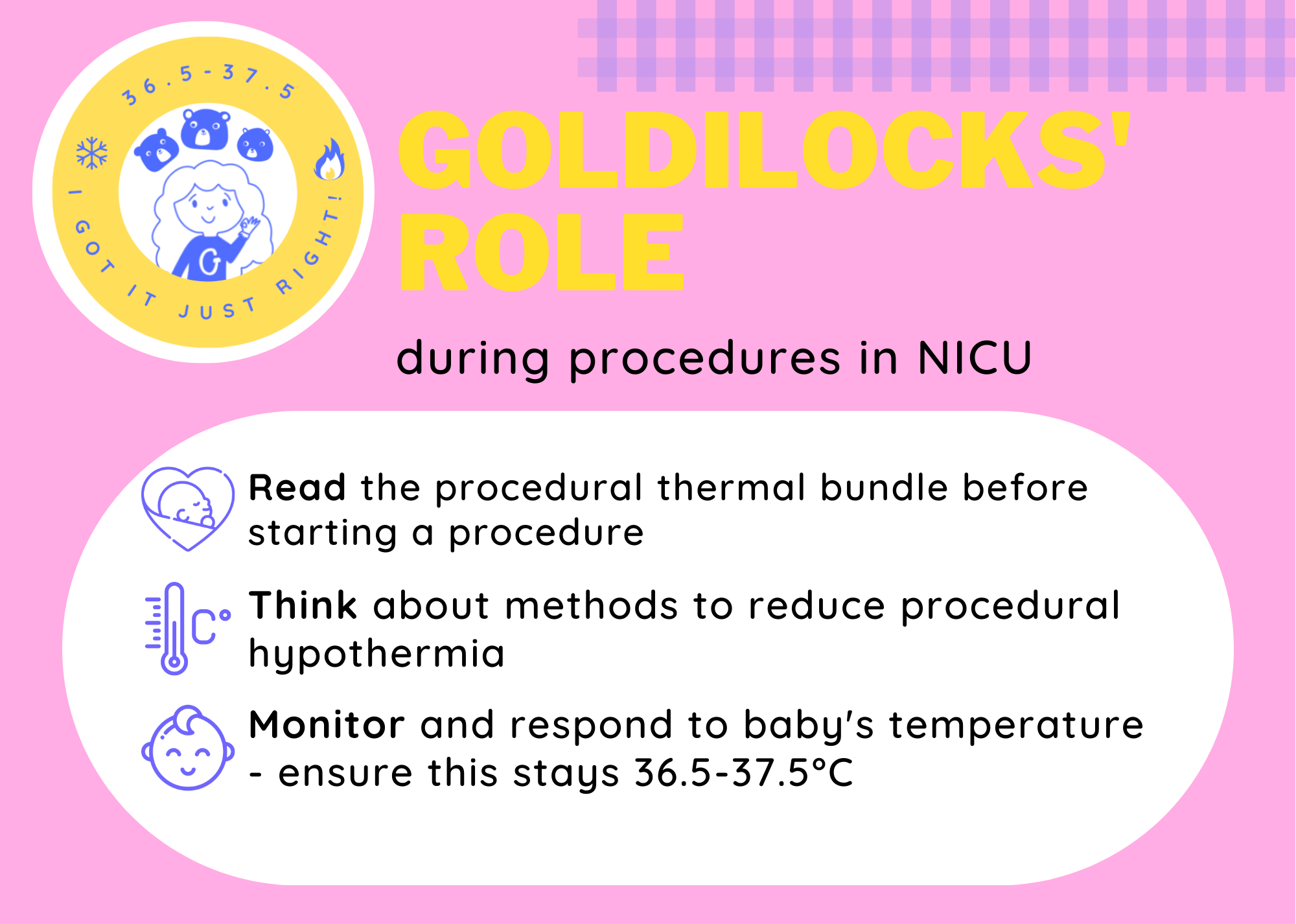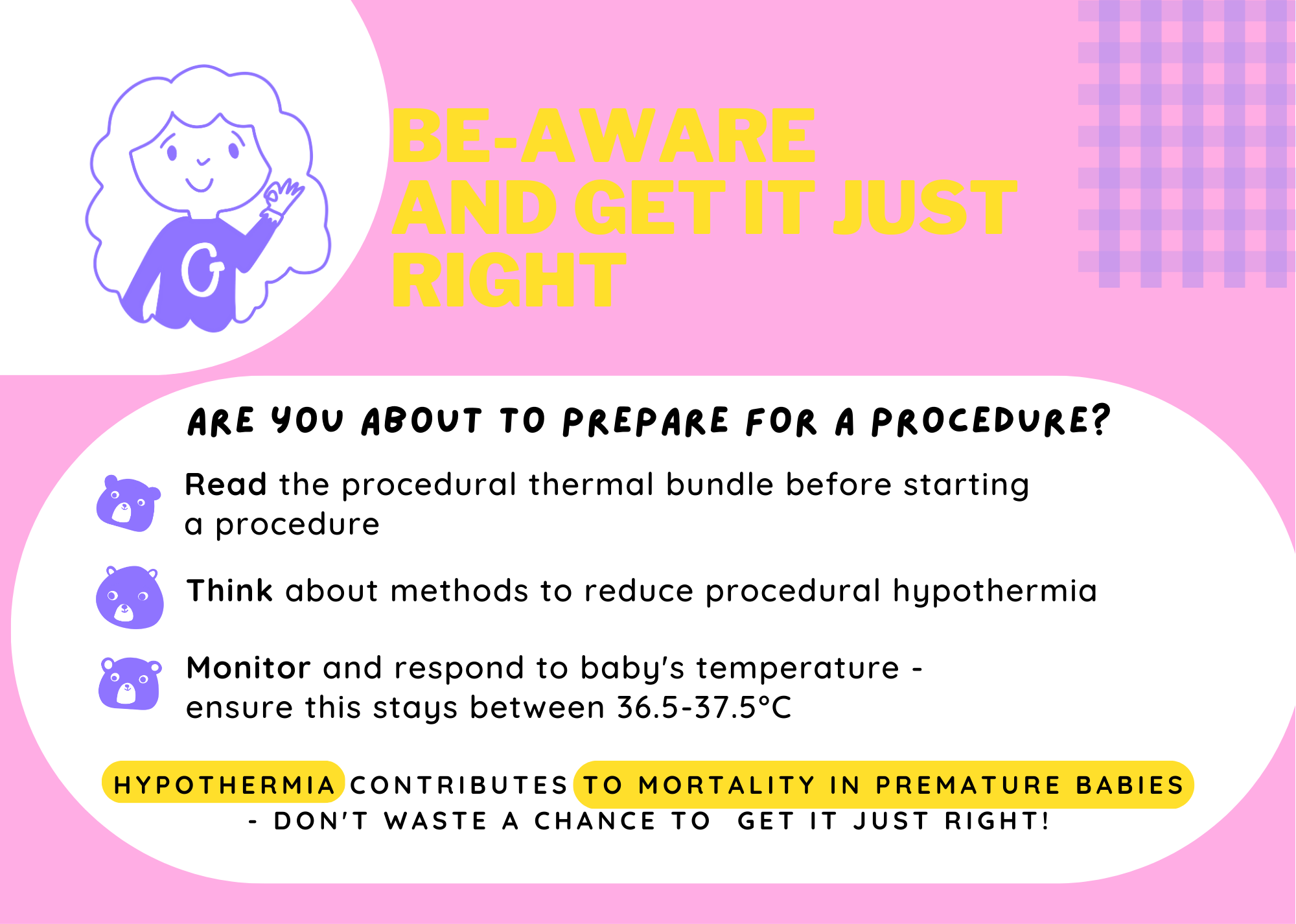Normothermia in the delivery room in premature infants
Maintaining normothermia, or normal body temperature, is critical for premature infants in the delivery room. Premature infants are at high risk for a range of complications including respiratory distress syndrome, low blood sugar, and infection, and hypothermia only increases these risks. By keeping premature infants warm through skin-to-skin contact with their parents, placing them under an overhead warmer, or using heated humidifiers, we can help to maintain their body temperature and reduce the likelihood of complications. Additionally, normothermia has been shown to improve long-term outcomes for premature infants, including better weight gain and reduced length of hospital stay. Therefore, ensuring normothermia in the delivery room is an essential component of providing optimal care for premature infants.
Maintaining preterm normothermia during stabilisation through role allocation.
Interventions proposed in The Goldilocks
and the three Be-Awares Project
Allocate a team member to the ‘Normothermia role’ before delivery of <32 wk baby ensure this team member is aware of the following responsibilities:
Optimise thermal measures prior to delivery: draughts, radiant heat, plastic bag, hat
Set the radiant heat to 80% on manual mode
Place the probe between the scapulae inside the bag. Give the probe 3 mins to stabilise.
Document temperature every 5 mins and prior to leaving the delivery room
Document thermal measures used in Badger
If the temperature is <36.5C -
Check probe position
Minimise draughts and seal the bag around baby
Increase heater by 20% to 100%
If the temperature is >37.2C
Reduce radiant heater
by 20% every 2 mins until stabilised
In NNU plug in the resuscitaire and record the temperature. Keep baby in a bag until early procedures are completed
Authors of the project: Dr Julie-Clare Becher (project lead, consultant neonatologist),
Dr Esther Falconer, Dr Sarah McDonald, Dr Catriona Broome
Graphic design: Dr Maggie Frej
Goldilocks and Three Be-Awares is a quality improvement project that has made a significant impact on the maintenance of normothermia in premature infants in the Simpsons Neonatal Unit. This project introduced a number of interventions, such as providing regular monitoring of temperature and adjusting the environment to maintain appropriate temperatures. The project also implemented a series of education sessions for neonatal staff to raise awareness of the importance of maintaining normal body temperature in premature infants. With these interventions and increased awareness, the project successfully reduced the incidence of hypothermia in premature infants, leading to improved health outcomes and reduced hospital stays.
Goldilocks Resources
Goldilocks QI Premature Normothermia Logo
Goldilocks QI Premature Normothermia Logo
Goldilocks QI Brand Kit
Be-Aware of the methods to reduce procedural Hypothermia - A5 awareness card
Be-Aware of the methods to reduce procedural Hypothermia - A5 awareness card
Be-Aware of the methods to reduce procedural Hypothermia - A5 awareness card
Goldilocks and Three Be-Awares
The prevention of hypothermia during the stabilization of a premature infant in the delivery room is essential to the health and wellbeing of the newborn. Role allocation and interventions can be effective in preventing hypothermia. The nursing staff should be responsible for ensuring the baby's temperature remains stable by implementing interventions such as providing a warm environment, using a radiant warmer, and providing skin-to-skin contact with the mother. The physician must oversee the situation and coordinate with the nursing staff to ensure the correct interventions are being used and monitor the baby's vital signs. By clearly defining roles and effective interventions, hypothermia can be prevented during the stabilization of premature infants in the delivery room, setting the stage for healthier outcomes for premature infants.








